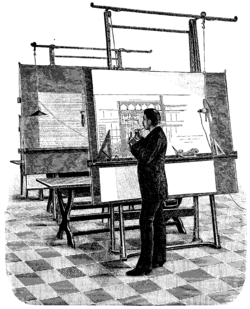Origins and History of Architecture
– Architect and engineer were interchangeable titles in ancient and medieval times.
– The term ‘architect’ comes from the Greek word ‘arkhitéktōn’ meaning master builder.
– The distinction between architect and craftsman emerged with advancements in technology and mathematics.
– The use of paper and pencils allowed for pre-construction drawings by professionals.
– Linear perspective and dimensional accuracy improved communication of design ideas.
Architecture as a Profession
– Legal practice of architecture requires appropriate license or certification.
– Representation as an architect is restricted to licensed individuals.
– Building design professionals have a broader scope of practice.
– Some design services can be performed by non-licensed individuals.
– Licensure involves university degree, exams, and training period.
The Role and Responsibilities of Architects
– Architects need technical, environmental, and business knowledge.
– Design is the driving force throughout the project.
– Architects work closely with clients to understand project requirements.
– Architects coordinate a design team including engineers.
– The architect ensures coordination to construct the design.
Architectural Design and Considerations
– Architects create design concepts that meet client requirements.
– Early proposals may rework the terms of the project brief.
– Design proposals should be imaginative and pragmatic.
– Consideration of space, end-use, connections, and materials is crucial.
– The site, environment, culture, and sustainability influence the design.
Collaboration and Specializations in Architecture
– Architects collaborate with engineers, surveyors, and specialists.
– Coordination of structural supports and systems is essential.
– Construction costs and planning are part of the architect’s role.
– Specialized communication and advanced technology aid coordination.
– Collaboration ensures successful implementation of the design.
– Rise of specializations within the profession.
– Focus on project types, technological expertise, or project delivery methods.
– Specializations in building code, sustainable design, historic preservation, etc.
– Architects moving into real estate development, project management, interior design, etc.
– Diverse career paths in architecture and related fields. Source: https://en.wikipedia.org/wiki/Architect
This article needs additional citations for verification. (October 2014) |
An architect is a person who plans, designs and oversees the construction of buildings. To practice architecture means to provide services in connection with the design of buildings and the space within the site surrounding the buildings that have human occupancy or use as their principal purpose. Etymologically, the term architect derives from the Latin architectus, which derives from the Greek (arkhi-, chief + tekton, builder), i.e., chief builder.
 An architect, 1893. | |
| Occupation | |
|---|---|
| Names | Architect |
Occupation type | Profession |
Activity sectors | Architecture Civil engineering Structural engineering Construction Project management Urban planning Interior design Visual arts |
| Description | |
| Competencies | Engineering, technical knowledge, building design, planning and management skills |
Education required | See professional requirements |
The professional requirements for architects vary from location to location. An architect's decisions affect public safety and thus the architect must undergo specialized training consisting of advanced education and a practicum (or internship) for practical experience to earn a license to practice architecture. Practical, technical, and academic requirements for becoming an architect vary by jurisdiction though the formal study of architecture in academic institutions has played a pivotal role in the development of the profession.
